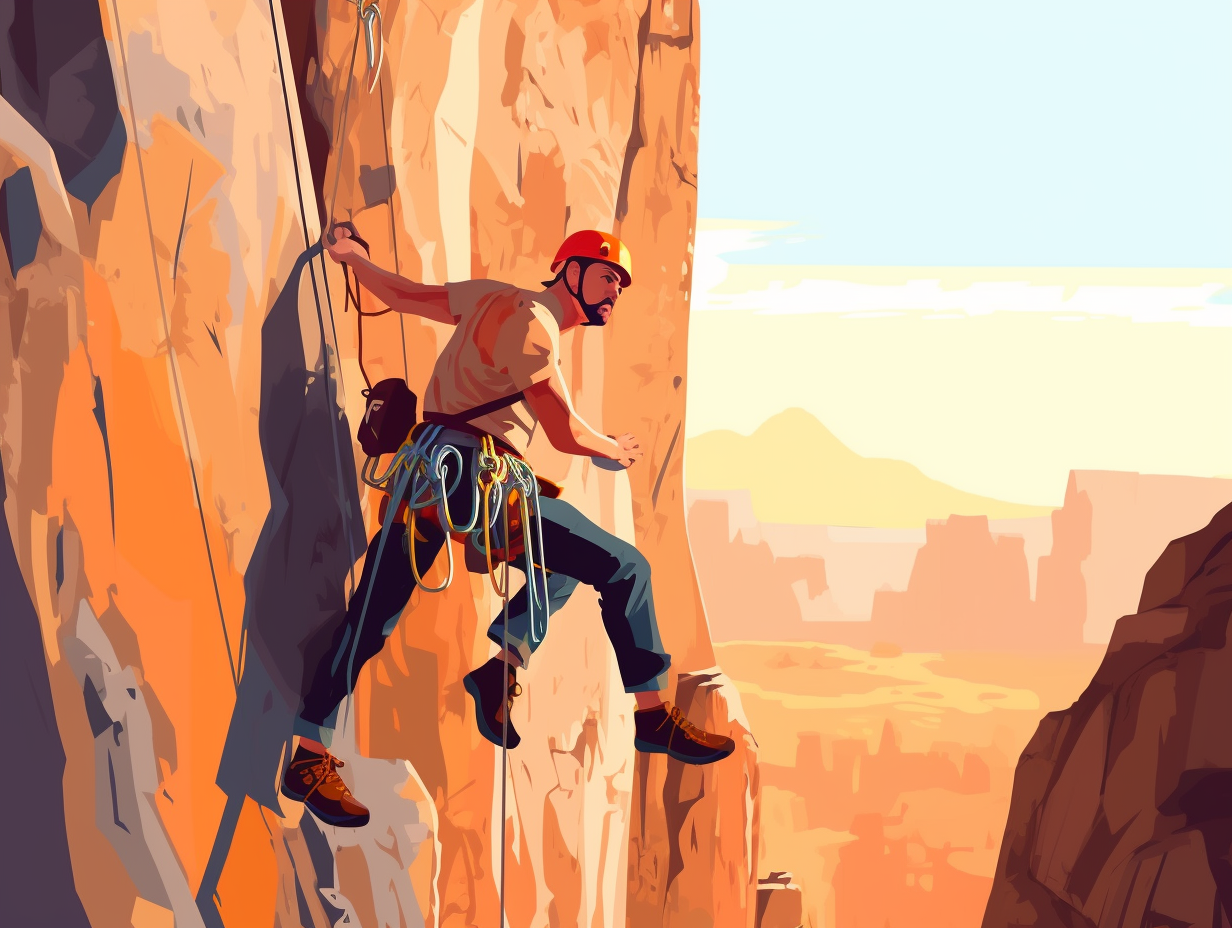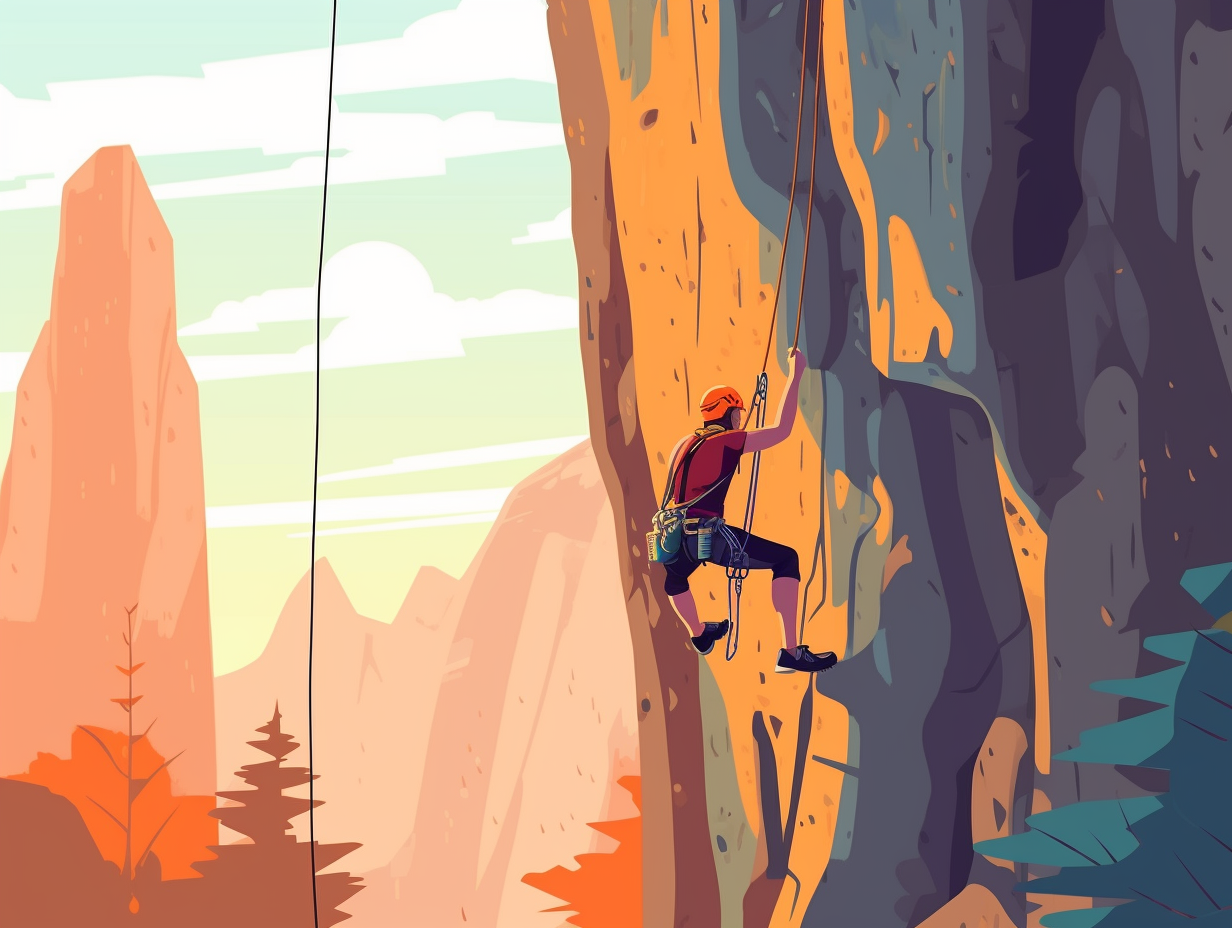13 Exciting Fun Facts About Rock Climbing You Never Knew: Learn, Climb, and Conquer!

1. Chalk: The Climber's Secret Weapon
Lo and behold, the mighty rock climbers have been keeping a secret weapon in their arsenal: the unassuming chalk! This humdrum substance, more commonly known to star in classrooms, has been moonlighting as a master strategist for adventurous ascenders: Chalk lets climbers not just keep their hands dry, but also mark out potential hand and footholds on the rocky canvas, helping them paint a masterpiece of their most successful route. So the next time you spot a white-powdered hold staring back at you from an indoor climbing wall, remember, it's chalk's subtle wink to the climber fraternity unraveling the secrets of their next gravity-defying act.
Source => 8bplus.com
2. The Power of Stretchy Climbing Pants
Climb into your stretchy pants and become Captain Elastic, conqueror of rocks and boulders: Investing in specialized climbing pants allows for maximum range of motion, breathability, and durability, making them the perfect partner for scaling new heights and nailing those epic spiderman-esque moves.
Source => mountainknowhow.com

Did you know that specific snacks can boost your energy and endurance while hiking? Discover the ultimate trail mix recipe and other nutrient-dense delights to keep you going for miles! 🌲⛰️🥾
=> Fun Facts about Hiking
3. Grip Strength: A Rockstar's Key
Want to climb the rock and roll hall of fame? Start by beefing up your finger-licking, grip-of-steel: Did you know that grip strength contributes to over 50% of performance in female climbers and almost 30% in male climbers? Training those forearm and grip muscles with activities like weightlifting and hand grip exercises will have you scaling walls like a true rockstar!
Source => ybellfitness.com
4. Two Types of Belay for Climbing Safety
While scaling the heights of hilarity and navigating the peaks of puns, remember that two can belay at this game – especially when rock climbing is involved: There are two primary categories of belay devices, tubular and brake assist, both vital in ensuring the climber's safety as they control the rope mid-ascent, making proper instruction an absolute necessity for all budding ascentionists.
Source => rei.com

5. Deep Water Soloing: Climbing's Breakup Therapy
Why did the rock climber break up with his girlfriend? He needed some "deep water soloing" in his life: a minimalistic climbing style over watery depths, requiring only courage and swim trunks instead of ropes and gear. Popular spots include Spain, Vietnam, and even Clear Creek in Arizona—but heartbroken mountaineers must first charter a boat to cast off to these exciting, overseas climbs.
Source => rei.com
6. Geology: Climber's Scratch-and-Sniff Guide
Rock climbers, behold: Mother Nature's own scratch-and-sniff guide to the great outdoors! That's right, say hello to your new best friend, geology: By studying the geologic time scale and different types of rocks, climbers can better understand the origin and characteristics of rock formations they face, ultimately enhancing their performance and safety on the wall.
Source => geoforward.com
7. Climber's Sixth Sense: Route Perception
Climbers have a sixth sense, or so they’d have you believe: skilled rock climbers possess a heightened perception of routes, remembering more info and zoning in on functional aspects of the wall while dismissing structural features, whereas, rookie climbers dwell on structural features and fail to recall crucial, clustered intel.
Source => researchgate.net
8. Cinderella's Rock Climbing Shoe Choice
If Cinderella were a rock climber, her fairy godmother might've conjured up some aggressively stylish kicks: different types of rock climbing shoes, like neutral, moderate, and aggressive, are tailored for specific climbing styles, and a perfect fit is snug, not glass-slipper-tight, for the ultimate power moves on the rock face.
Source => rei.com
9. Arm Charm: Climbing's Full-Body Workout
Rock climbers put the "arm" in "charm": This gravity-defying sport actually involves a head-to-toe workout, targeting not just the upper body, but also the legs and core. Climbers end up with impressive muscles, such as formidable forearms, boasting biceps, tremendous triceps, delightful deltoids, luscious lats, and triumphant traps. Ladies, don't let those guns fool you - your lower center of gravity gives you an edge in this thrilling activity, as rock climbing both challenges and builds that all-important core and upper-body strength.
Source => womenshealthmag.com

10. Sherlock's Climbing Prediction: Finger Strength
Forget Sherlock Holmes' science of deduction, rock climbers have their own method for predicting success: it's called the Maximum Voluntary Contraction (MVC) of your finger flexors! Measured through hangboard training, this finger strength stat can accurately foretell a climber's bouldering grade, taking into account factors like height, weight, and training mode. Sherlock may have been able to crack cases with just a magnifying glass, but these climbers can crush rocks with just one or two fingers.
Source => strengthclimbing.com
11. Feeling Knotty: Climbers and Rope Skills
If you're feeling knotty and you know it, touch the rope: The most commonly used knot in rock climbing gyms is the Trace-Eight knot, a versatile loop that climbers use to securely tie themselves to the rope for both leading and top-roping. Before stepping foot on the climbing wall, gym-goers must prove their knot-tying prowess and the mastery of this specific knot, although experienced climbers might also use the Ring Bend or Double Fisherman's Bend for different climbing situations. Remember, safety and knot expertise go hand-in-hand when defying gravity!
Source => climbing.com
12. Dirty Dancing on Rocks: Footwork Finesse
Dancing their way up perilous rock faces as if starring in an adrenaline-fueled sequel to Dirty Dancing, rock climbers have the secret sauce to climbing success: footwork finesse! The toe-tapping tips from professional climber Paige Claassen include warming up with quiet feet, weighting the toes, strategic moves, core engagement, utilizing different foot parts, and well-fitting shoes – ensuring a slip-free, energy-efficient climb of the highest order.
Source => climbing.com
13. Free Solo Climbing: Adrenaline's Cousin
Hanging by a thread, or rather, their fingertips: Free solo climbing is that adrenaline-packed cousin of rock climbing where climbers bid adieu to safety gear, opting to scale sheer cliffs with nothing but their bare hands - though only a brave few dare to attempt this risky hobby since one misstep could lead to a not-so-humble plummet.
Source => theundercling.com










